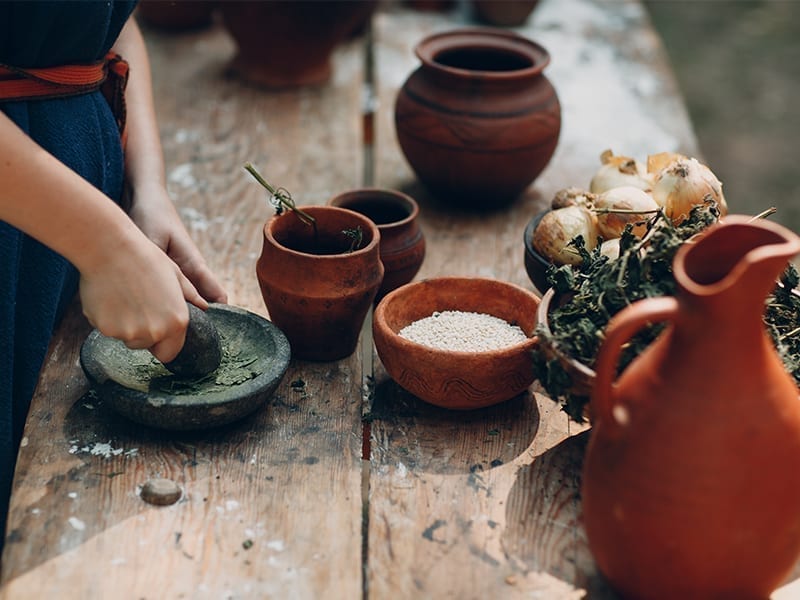When you grow up in India, it’s practically impossible to spend a single day without hearing of an Ayurvedic solution to a problem. Considering how the tradition of Ayurveda is more than 5000 years old, it has become a part of our collective consciousness as Indians. It is a school of thought that covers a vast spectrum of topics, ranging from skincare and diet to lifestyle choices and mental health. Here are five simple and practical ways that you can incorporate the teachings of Ayurveda into your life, without having to make any radical changes.
Adding Ayurveda To Your Daily Routine
1. Practice Mindful Eating

While you are having your meals, avoid sitting in front of the television or using your phone. According to the Ayurvedic philosophy, the food that is on your plate deserves the utmost attention and respect as it keeps you nourished and alive.
Being conscious of what you eat allows your body to properly digest the food you have consumed. Chewing your food well and slowly helps your food break down better, since the digestive enzymes in your saliva have time to act upon the food. This also helps your metabolism work more efficiently.
2. Start Your Day Right

The first thing you should consume just after waking up is a glass of lukewarm water. The warm water kicks off the metabolic process and aids in weight loss and muscle tone. This is a practice that has been passed down to us from ancient times and has been gaining popularity in the West in recent years.
Have a breakfast that’s filling, but not heavy. Ayurveda suggests that different constitutions, or dosha types, should consume different types of food for breakfast. Vata types are recommended breakfasts that are warm and sweet, while pitta types benefit from breakfasts that are cool, dense, and dry. People with a kapha dosha should be inclined towards breakfast foods that are warm, light, and slightly sour in taste. Here are some effective home remedies for kapha dosha, try them out.
Here are 5 Indian superfoods that are great for breakfast as well. Alongside this, try to go to bed and wake up at the same time every day. In Ayurveda, a regular routine and sleep schedule helps to maintain your circadian rhythm, which gives you more energy and increases your overall productivity.
3. Massage Your Body

Abhyanga is the Ayurvedic practice of massaging yourself with warm oil. It should ideally be done about half an hour before you take a bath. It is described as a way of giving your mind, body and spirit respect and nourishment for keeping you fit and healthy. It is a form of self-care that also improves your immune system.
Abhyanga is also a great way to regularly check in with your body and understand your natural rhythms. You get to know yourself while keeping track of any changes, especially for older women. It’s the perfect time to notice any new moles and check your body, especially your breasts, for any odd lumps or formations.
Abhyanga provides a number of health benefits, including increasing circulation and detoxification, softening the skin, toning the muscles, easing stress and anxiety, improving sleep quality, and lubricating the joints.
Did You Know?
Chyawanprash is one of the most powerful Ayurvedic medicines. Chyawanprash has a number of potent health benefits and can even be used effectively by kids. A recent study has observed that Chyawanprash has been instrumental in improving kids’ immunities, after being consumed for six months.
4. Cleanse Your Skin

Ayurveda recommends that you should start off your skincare routine by exfoliating. Mix some gram flour (besan) with a few teaspoons of water and make a thin paste. Apply it to your face and neck and massage it softly with the fingertips of your second, third and fourth fingers. This will gently get rid of the dead cells, while the besan gives you a fresh and clean feel.
After exfoliating, put some rose water in a spray bottle and spritz to keep your face plump and moist. Lock in the hydration with some jojoba oil, which is very mild and anti-inflammatory.
5. Practice Gratitude & Calmness

The Ayurvedic philosophy for mental well-being is very closely linked with the schools of yoga and meditation. According to Ayurveda, the harmony of the soul and the body is critical for self-actualisation. But don’t let these words dissuade you. Meditation can be as simple as you make it. You can even practice it at any time of day that suits you. Just take some time out of your day to breathe deeply and be in tune with your thoughts and consciousness. Meditation combined with yoga can be effective for balancing pitta dosha.
Some practitioners recommend recalling the events of the day and making a list of all the things that went right, as well as the things and people you are grateful for. This allows you to be much more at peace with yourself and plants positivity and optimism in your perspective.
Some very small and incremental changes in your everyday life can make you happier, fitter and healthier. Try these methods for a short period of time, just to test out their efficacy. At the end of that time, ask yourself about the changes you have undergone.
Am I calmer? Is my skin better? Do I feel healthy? How is my mental health? The answers will surprise and motivate you. Read more to learn about the characteristics, diet, lifestyle habits, symptoms & home remedies of the vata dosha.

